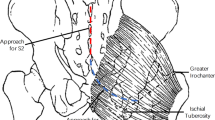Abstract
PURPOSE: Functional neosphincters after pudendal nerve anastomosis proved possible in animal models and may be applicable in humans, but access is a recognized problem. We report the occurrence of pudendal nerve anomalies, its implications for reconstruction, and describe a new approach for maximal exposure. METHODS: Adult human cadavers were positioned prone and dissectedvia a gluteal approach. Pudendal nerve variations and physical measurements were analyzed statistically. RESULTS: A new, simple, four-step approach (surface landmarks and exposure of gluteus maximus muscle, sacrotuberous ligament, and pudendal neurovascular bundle) permitted optimal pudendal nerve exposure in all 14 human cadavers (28 limbs). Six were males and had a mean age of 82 (range, 58–102) years. Two anomalies, Type 1 (2-trunked) and Type 2 (3-trunked), of the pudendal nerve were recognized in 30 percent of cadavers, with a left-to-right ratio of 2.5:1. Mean pudendal nerve length over the ischial spine was 23.9 (range, 19–28) mm right, 24.2 (range, 19–28) mm left (P=0.54), but its diameter measured 5.2 mm (right) and 4.9 mm (left;P=0.04). Mean length of pudendal nerve trunk exposed after reflection of the sacrotuberous ligament was 55 (range, 44–75) mm on either side before division into terminal branches. The number and percent frequency of inferior rectal nerve on both sides were 1 (13 percent), 2 (76 percent), and 3 (11 percent), respectively, with a mean length of 27.1 (range, 21–34) mm right and 27.9 (range, 20–33) mm left (P=0.31). CONCLUSION: A simple four-step approach to the pudendal nerve contributes to improved access in all cases. It facilitates reconstruction because it allows accurate nerve selection and recognition of potential anomalies that might influence functional outcome.
Similar content being viewed by others
References
Schmidt E. The continent colostomy. World J Surg 1982;6:805–9.
Pickrell KL, Broadbent TR, Masters FW, Metzger JT. Construction of a rectal sphincter and restoration of anal continence by transplanting the gracilis muscle. Ann Surg 1952;135:853–62.
Bruining HA, Bos KE, Colthoff EG, Tolhurst DE. Creation of an anal sphincter mechanism by bilateral proximally based gluteal muscle transposition. Plast Reconstr Surg 1981;67:70–2.
Abercrombie JE, Williams NS. Total anorectal reconstruction. Br J Surg 1995;82:438–42.
Williams NS, Patel J, George BD, Hallan RI, Watkins ES. Development of an electrically stimulated neoanal sphincter. Lancet 1991;338:1166–9.
Baeten CG, Konsten J, Spaans S,et al. Dynamic graciloplasty for treatment of faecal incontinence. Lancet 1991;338:1163–5.
Sato T, Konish F. Functional perineal colostomy with pudendal nerve anastomosis following anorectal resection: an experimental study. Surgery 1996;119:641–51.
Congilosi SM, Johnson DR, Medot M,et al. Experimental model of pudendal nerve innervation of a skeletal muscle neosphincter for faecal incontinence. Br J Surg 1997;84:1269–73.
Sato T, Konishi F, Kanazawa K. Anal sphincter reconstruction with a pudendal nerve anastomosis following abdominoperineal resection: report of a case. Dis Colon Rectum 1997;40:1497–503.
Shafik A. Endoscopic pudendal canal decompression for the treatment of faecal incontinence due to pudendal canal syndrome. J Laparoendosc Adv Surg Tech 1997;7:227–34.
Shafik A, el-Sherif M, Youssef A, Olfat ES. Surgical anatomy of the pudendal nerve and its clinical implications. Clin Anat 1995;8:110–5.
Sikorski A, Olszewski J, Miekos E. Anatomical considerations of selective pudendal neurectomy. Int Urol Nephrol 1987;19:159–63.
Sato T, Konishi F, Kanazawa K. Functional perineal colostomy with pudendal nerve anastomosis following anorectal resection: a cadaver operation study on a new procedure. Surgery 1997;121:569–74.
Vrahas M, Hern TC, Diangelo D,et al. Ligamentous contributions to pelvic stability. Orthopedics 1995;18:271–4.
Vukicevic S, Marusic A, Stavljenic A,et al. Holographic analysis of the human pelvis. Spine 1991;16:209–14.
Author information
Authors and Affiliations
Additional information
Mr. O'Bichere is supported by a grant from St. Mark's Hospital/Northwick Park Institute for Medical Research and Dansac Limited. Presented at the “Short Article Meeting” Section of Coloproctology, Royal Society of Medicine, London, United Kingdom, November 25, 1998.
About this article
Cite this article
O'Bichere, A., Green, C. & Phillips, R.K.S. New, simple approach for maximal pudendal nerve exposure. Dis Colon Rectum 43, 956–960 (2000). https://doi.org/10.1007/BF02237358
Issue Date:
DOI: https://doi.org/10.1007/BF02237358




